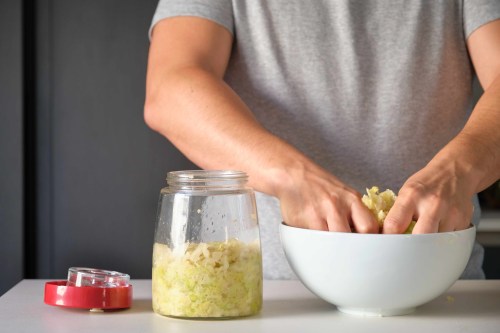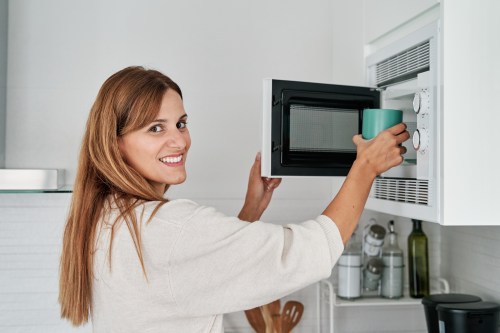Our editors independently select these products. Making a purchase through our links may earn Well+Good a commission
‘I’m a Food Scientist, and This Is the Machine That Makes the Best Cup of Coffee’
Brewing coffee is a chemistry experiment. The best coffee machines take the guesswork out of the process, says food scientist Makenzie Bryson Jackson.

You could have the best beans in the world, but the extraction process ultimately determines how your cup of coffee turns out. “Brewing coffee is a chemistry experiment: It comes down to using water as a solvent to extract compounds from coffee beans,” says Makenzie Bryson Jackson, MS, food scientist and product development manager at Panaceutics. “And every extraction method brings out different notes in the coffee beans.” The best coffee machines, she says, take the guesswork out of the process. But different machines yield different results.
Experts in This Article
food scientist and product development manager at Panaceutics
First, Jackson says to make sure you have clean quality water, fresh beans, and a good grinder. Then, focus on the three T’s of the extraction process: “That’s time, temperature, and turbulence,” she says. “Time is how long the water is in contact with the coffee grounds—the longer it is, the more compounds will be extracted. Not enough time results in under-extraction: sour, weak, and watery. And going too long results in over-extraction: bitter, hollow, and burnt notes.”
As for the temperature, the optimal range of water temperature for extracting is between 195 and 205 degrees. And the last T—turbulence—happens as water flows over the ground coffee. “If you pour water too slowly, it could create tunnels and not all of the grounds may be uniformly wet,” says Jackson. “When you make a coffee that’s fully submerged before filtering, such as when using a French press, you want to stir it to ensure all of the bean particles are exposed to water.”
Jackson employs five different coffee brewing methods at home, each requiring a little more effort than the last. While some machines do most of the work for you, others will take a little more effort. But no matter which you prefer, there isn’t a wrong way to enjoy your coffee. “Perfection is all in the tastebuds of the sipper,” she says. “There are some machines like Nespresso and Keurig that try to take all of the guesswork out of brewing coffee, and if you like those, that’s also fantastic.”
The best coffee machines, according to a food scientist
1. Rancilio Silvia Espresso Machine, $735
Out of all the coffee machines in Jackson’s kitchen, the Rancilio espresso machine is hands-down her favorite and the one she uses almost every day. “It works to brew by pushing pressurized water through finely-ground coffee in a ‘puck.’ It creates a unique concentrated coffee shot that’s rich and indulgent,” she says. “My recommendation is to have an espresso machine with a copper boiler. Copper is the best thermal conductor and will hold up for years. My machine allows for me to control the temperature and extraction time, as well as the volume of water pushed through the puck.”
Shop now:Rancilio Silvia Espresso Machine, $735
2. Chemex Pour-Over Glass Coffeemaker, $47
Whenever Jackson wants a cup of smooth drip coffee, she always reaches for her Chemex. “It looks like a vase with the filter paper at top. The grounds are put in a filter and the hot water is poured over the grounds and gravity pulls the water into the vessel,” she says. “This method allows me to control a lot of variables like water temperature, extraction time, and the weight of the water and coffee grounds. The Chemex filter paper is made to absorb oils, sediment, and fatty acids and creates a smooth delicious flavor.” Jackson uses a coffee scale ($19) to precisely weigh the grounds as well as a digital timer ($13) for the pours and drip.
Shop now:Chemex Pour-Over Glass Coffeemaker, $47
3. Bodum Chambord French Press Coffee Maker, $36
For a robust cup of coffee with minimal effort, Jackson uses a French press. “You put the ground coffee in the bottom with water at 200 degrees, and let steep for 3 to 5 minutes. Then, you depress the plunger,” she says. “You get a higher caffeine content and a very bold strong flavor because the coffee grounds are in direct contact with the hot water with no paper filter. It will also have the oils, sediment, and fatty acids.”
Shop now:Bodum Chambord French Press Coffee Maker, $36
4. AeroPress Coffee and Espresso Maker, $39
For great coffee on the go, Jackson says the AeroPress is your best bet. “I bring it with me when I travel because it’s light, durable, and easy to clean,” she says. “It operates like a giant syringe, allowing the grounds to be in contact with the coffee for whatever amount of time is preferred, and then the water is pushed through a filter into the cup. This method allows for a lot of control: water temperature, extraction time, and rate of pressing through the filter.”
Shop now:AeroPress Coffee and Espresso Maker, $39
5. Bialetti Moka Express Stovetop Coffee Maker, $30
The affordable, timeless alternative to espresso machines is Bialetti’s stovetop moka pot. “The stovetop method uses steam pressure to brew strong coffee that tastes like espresso. It was invented in the 1930s and is a fun vintage way to make coffee,” she says. “This is also a great option for camping, or if you want to have something espresso-like without the price tag that comes with an espresso machine.” There is a downside, though: Jackson says there isn’t as much room for customization or control with this option, and there’s a danger of over-extracting the beans.
Shop now: Bialetti Moka Express Stovetop Coffee Maker, $30
For more healthy recipes and cooking ideas from our community, join Well+Good’s Cook With Us Facebook group.








